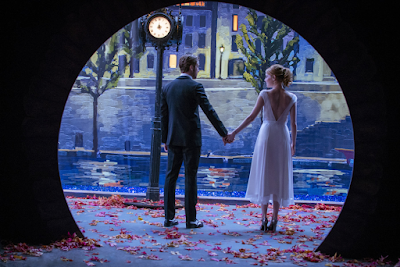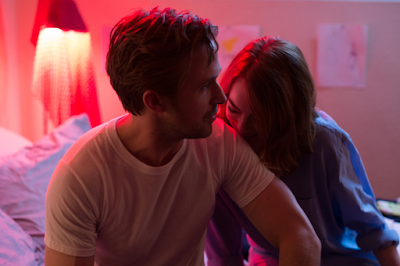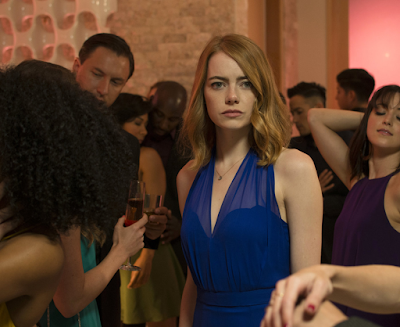On the evidence of Whiplash and La La Land (2016), director Damien Chazelle sure likes jazz. He likes it so much that he wants to save it from its death spiral, single-handedly if necessary. Maybe he'll succeed. I don't know. I wish he'd try harder to save it with actual black people, you know? The people who actually invented jazz? But, like it or not--and this film doesn't--black people have moved on to other forms of expression, leaving jazz to (mostly white) academics and nostalgics. I think Chazelle is an academic, however much he wants to express a visceral passion for jazz in his films. There's a scene in La La Land where he tries to convey what jazz has become versus what he thinks jazz ought to be when he has his hero, Sebastian, a jazz pianist, trying to mansplain why his heroine, Mia, an aspiring actress, should like jazz even after she's said she doesn't like it. This resonated in my head with some recent articles in Seattle's The Stranger about bands one woman pretended to like to impress boys and it dropped me out of the movie for few minutes, a discordance that echoed back later in the film where the filmmakers tip their hats to Vertigo, which similarly follows a man who wants to remake a woman. So, basically, the politics of images in La La Land are somewhat problematic.
Also, on the evidence of the film, it's easier to teach actors to dance than it is to teach them to sing. Whatever their respective talents, Ryan Gosling and Emma Stone are not going to be remembered in the same breath with Fred Astaire and Ginger Rogers. Can't sing, can dance a little, as the line on Astaire once read. I've already had apologists for the film suggest to me that this is talk-singing as performance and, well, that just doesn't wash with me. It's more a symptom of a system that can no longer develop those specific talents in actual by golly movie stars if they don't already come equipped. I'll give both Gosling and Stone props for fearlessness, and for incorporating something really fucking hard into their performances, but I don't really want to listen to them sing. Seriously, where is Marni Nixon when you really need her, eh? I can watch them dance because movie-star charisma has some value when it's in motion. Chazelle, for his part, sticks with his choice as it takes him over Niagara Falls, and power to him for not taking the shitty dishonest way out that Chicago took by creating "performance" with fast editing and careful framing. Chazelle films Gosling and Stone the way Stanley Donen and Gene Kelly would have filmed them: head to toe, with no tricky edits. He lets them sink or swim. Sometimes they manage to dog paddle. The film's best sequence is its first, in which the drivers stuck in LA traffic get out of their cars and sing and dance. Since this sequence doesn't require the appearance of its stars, the filmmakers have mostly stocked it with people who are obviously professional dancers and singers. It makes a difference.
Mind you: I liked La La Land. I think its cinematic savvy carries it through and it's fun to watch. The relationships it portrays, even as cliched as they are, are well plotted and well-acted. Indeed, this is a film that values a lot of things I value: vinyl records, movie theaters, classic Hollywood, making art that's good rather than art that's commercial. This all strokes my cinematic joy. Even though I don't particularly want to hear them sing, I like Emma Stone and Ryan Gosling. The light bounces off of them differently than it bounces off ordinary mortals, in ways that illuminate the fantasy in which they appear. I'm glad that filmmakers have the sense to cast them together in movies. I even like that they tend to appear in Old Hollywood kinds of movies (Crazy Stupid Love, a rom com, and Gangster Squad, a crime film set in the 1940s, this). Hell, I'd love to see them together as Nick and Nora Charles or as Sam Spade and Brigid O'Shaugnessy. When you have traditional movie stars, you use them like traditional movie stars. This film is at least that smart. Its rags to riches, A Star is Born narrative is Old Hollywood to the core, complete with appropriate nods for all you film scholars out there. It doesn't even hide its allusions much when it's not name checking them outright. The film's second best scene, when Mia and Sebastian are dancing on the stars in Griffith Observatory layers allusion on top of allusion in a way that's almost too rich to digest. This scene dodges any complaints I may have about the terpsichorean abilities of Stone and Gosling because nobody is a good dancer when wired into a flying harness.
Fortunately for the film, La La Land is not an opera or operetta where all of the dialogue is sung. The scenes in between play to the talents of its stars. Indeed, the film as a whole plays to the talents of its director, who takes his love of jazz to the art of filmmaking. Like Whiplash before it, it's edited with the syncopated precision of a jazz drummer. The film has a nice sense of doomed romanticism, too, which is evident almost from the get-go. It could resolve in a happy ending--indeed, the film's most bravura conceit is to show the audience the kind of happy ending that might be expected of it. But it doesn't go there in the end. In the end, love breaks its lovers apart and leaves them nothing but lost and brokenhearted. But that's another musical idiom entirely.

This blog is supported on Patreon by wonderful subscribers. If you like what I do, please consider pledging your own support. It means the world to me.



















No comments:
Post a Comment